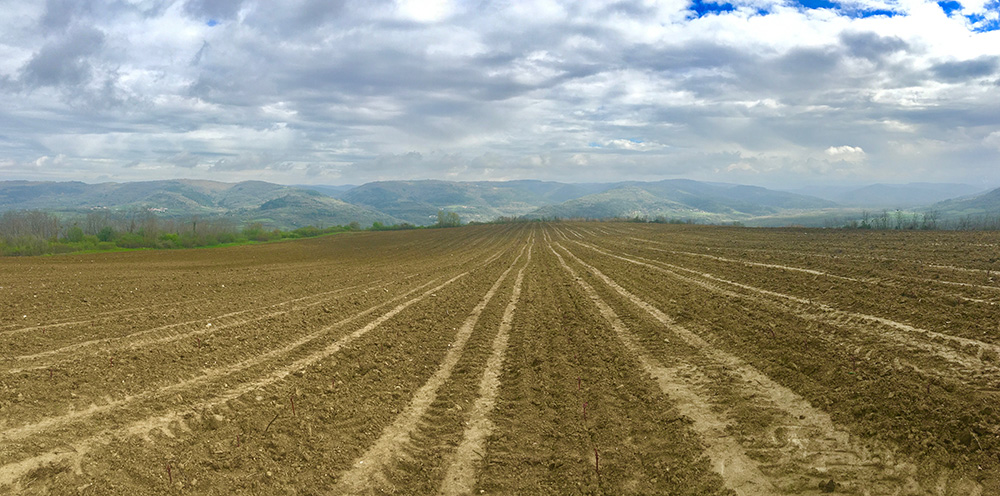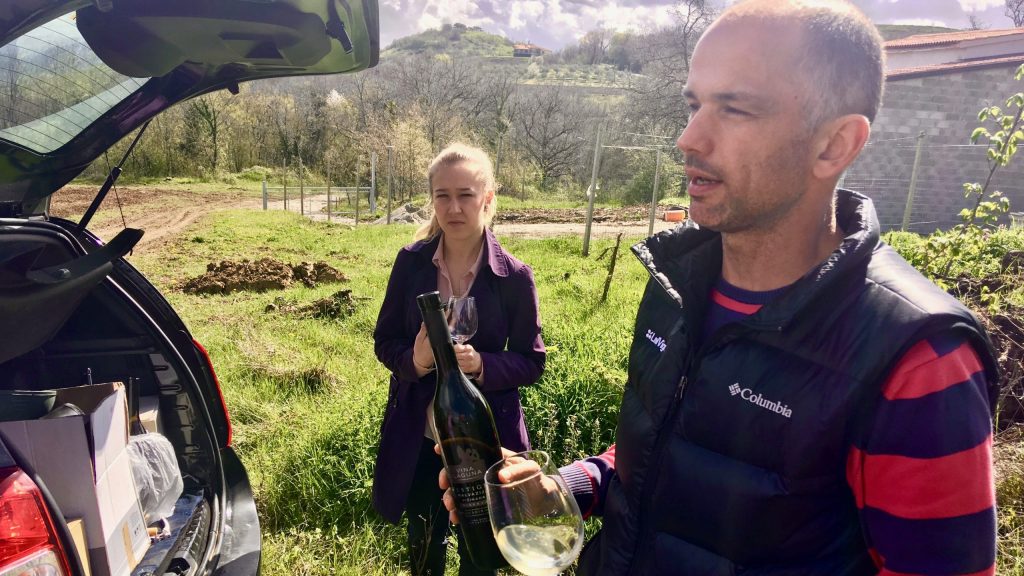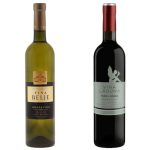First the jeep got stuck in the mud created by the night rain shower on the gravel road towards one of Laguna’s vineyards in Vižinada. Then the passengers of the jeep, chief oenologist of Laguna Milan Budinski, spokesperson Mia Vukdragović and the Plava Kamenica team, began trudging through mud to the position where these days new vineyards of Malvazija are being erected. Mud on white soil, as Budinski put it, can sometimes remind of a milder version of quick sand. Although it was only a hundred meters away, we carried several kilograms of mud on our boots. But it wasn’t a problem. On the contrary, the depth and strength of the soil turned into a sticky, slimy, dense mass showed us not a soil as a basis for vines or something else, as it is most commonly viewed by those not working the land, but as a might natural element whose energy is eventually reflected in the wine. And from Vižinada, located some fifteen minutes’ drive from Poreč inland, come some of the most particular and best wines of Istria. Which may become more particular in several years.
The planting of new Laguna vineyards in two Vižinada positions, on a total of 23 hectares, is not a regular replacement of old and unproductive vineyards. It is a completely new cultivation model which Laguna decided to introduce at this prestigious location. The new vineyards on Vižinada will be cultivated ecologically. Not only for the quality of the wine, but also to preserve the very soil the vines grow on.
Laguna understands that ecological cultivation is not a fashion trend, but the future of quality winemaking and vine growing, so these vineyards will serve as a model for gradual transfer of the entire, huge Laguna wine-vine growing program encompassing 580 hectares, to a more natural cultivation regime.

If these plans are accomplished, Laguna’s ecological project could dramatically alter the vine growing image of Istria and Croatia, as never before in Croatia has such a large wine company undertaken such modern steps, mostly expected from boutique wineries. The rule stating the small lead and big follow may be turned around here.
“The transfer to ecological production is not a marketing trick for us,” says Milan Budinski. “Moving to ecological production is for us a way to preserve the natural wealth of the areas our wines come from. One of the basic characteristics of the Istrian white soil is the high vine growing value, due to its mechanical composition which is prone to erosion. Once the sensitive natural balance of the biologically active surface layer is disrupted, the soil here quickly loses fertility, turning into dead soil which every rain or vehicle damages irreversibly. The issues of natural wealth degradation of the soil were first seen right on this sensitive white soil area, while our vineyards on the Istrian red soil, famous terra rossa, are somewhat more resistant to the negative anthropogenic degradation. With time we also wish to apply the principles of responsible land management on the red soil, which we will learn from these most sensitive positions,” continued Mr Budinski, while the morning sun over Vižinada was slowly drying the mud.
“Now, this entire process does have a clear economic calculation. We don’t want for quality and condition of vineyards at our best position to degrade, as that would naturally reflect on the quality of wine. Specifically, ecological production emphasizes soil maintenance, careful planning of work operations which will reduce the degradation of soil, maintaining a natural green cover in the vineyards and bolstering the biological activity of the soil. It is clear that the greater part of what is called ecological production mandates the use of ecological protection products. In fact, the approach must be holistic, beginning with the selection of a natural prime position where diseases are not common or are rare, to the maintenance of the vineyard which creates a natural balance, making it healthy and fertile in the long term.”
After we got ourselves out of the mud, we drove to the second of Laguna’s vineyards which is being planted on Vižinada, where around 11 in the morning we tasted several recent Malvazija Vižinadas. Of course there is nothing better than to taste wine in nature, in the vineyard, even in a future vineyard, with a view of the vineyards growing the grapes for the wine. The 2015 Vižinada is very opulent, elegant, with lots of freshness, very intense taste, long mineral ending, but is still slightly closed on the nose. The 2016 Vižinada is not on the market and will probably be even better. In this phase it is more open on the nose, with flower-citrus aromas, recognizable taste intensity and with strong, precise, linear profile in the mouth. Mineral ending with slight saltiness is again easily recognizable. Both of these wines belong among the best Malvazijas produced in recent years.
Laguna’s Malvazija Vižinadas are vinified without contact with wood and without real maceration, although col soaking of grapes before pressing can be considered some sort of mild maceration. These Malvazijas are nevertheless very, very luxurious in texture and almost dense. They are also relatively easily recognizable by terroir, which is the credit of the Vižinada soil.
“These are typical, superior vine growing positions on elevated hilly terrain at 240 to 270 meters above sea level,” explained Mr Budinski. “The specific position of these vineyards causes constant flow of air towards the Mirna River. This soil in Istria we call white soil. In fact, it is a poorly developed type of rendzina on flysch. The soil is abundant in calcium and magnesium minerals, which is manifested in the structure and taste of wine. Minerals, or their salts, created during the ripening of grapes, through the neutralization of natural acids of wines from such positions create great, elegant wines based on long, but non-aggressive acidity, saltiness and slight bitterness. These characteristics are the consequence of calcium and magnesium salts. Thus these wines can truly be described as mineral.” The chief Laguna oenologist repeated several times that he regrets we were not joined by Miroslav Latal, the chief Laguna vine grower, who monitors and executes vineyard operations each day, including the planting of new, replacement vineyards in Vižinada.
Returning from Vižinada, we discussed with Budinski on the real reaches of Istrian Malvazija. We agreed that fresh and clean must not be the only definition of Malvazija, regardless of the fact that fresh Malvazijas are an easy sell. Istrian Malvazija can give especially complex, internationally valuable wines of various styles, witnessed by Laguna’s 2013 Vižinada which is now in optimal form, as is Kozlović’s Santa Lucia from 2015 or Coronica’s Gran Malvasia 2015. Laguna’s ecological vineyards on Vižinada will yield grapes in three years, and are a huge step toward positioning Malvazija as a variety for a great, global white wine.
Translated from Plava Kamenica, for the original click here.











